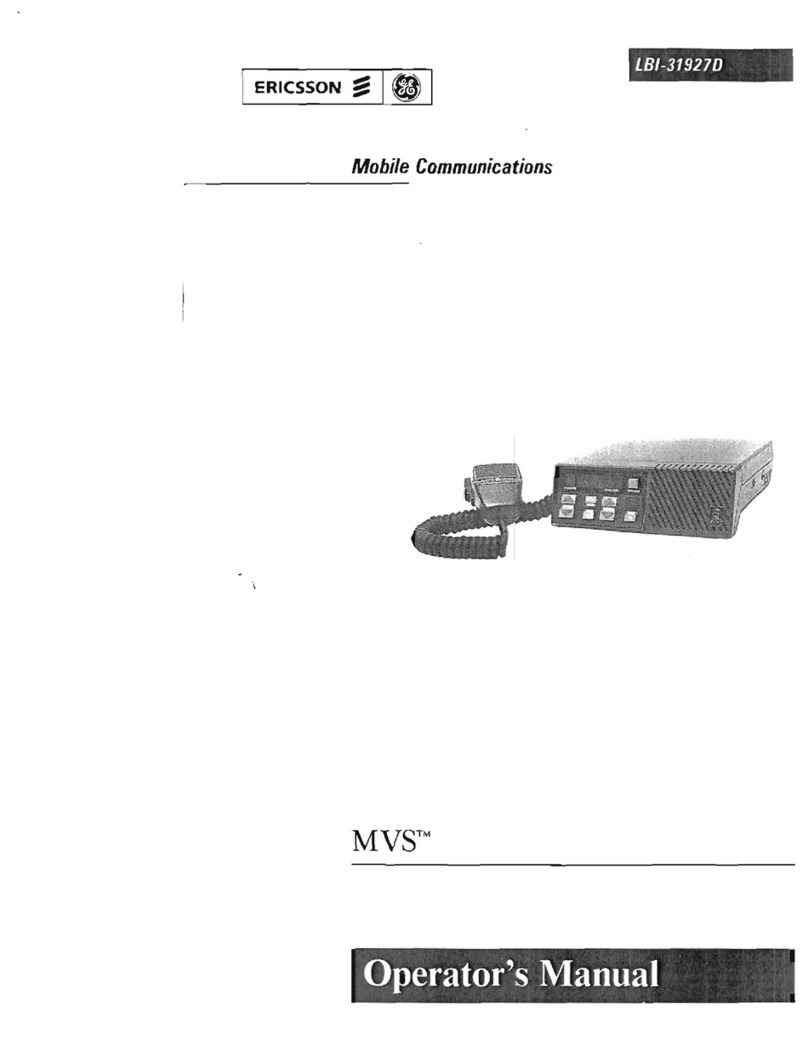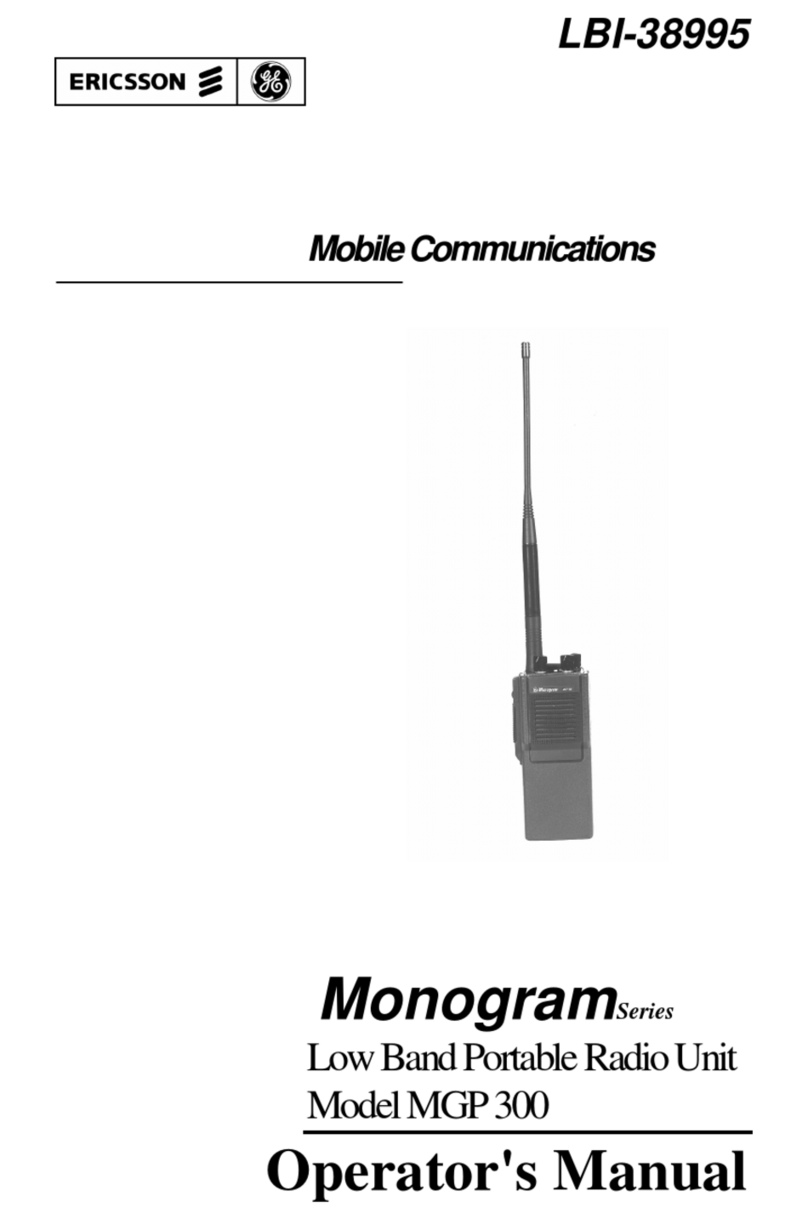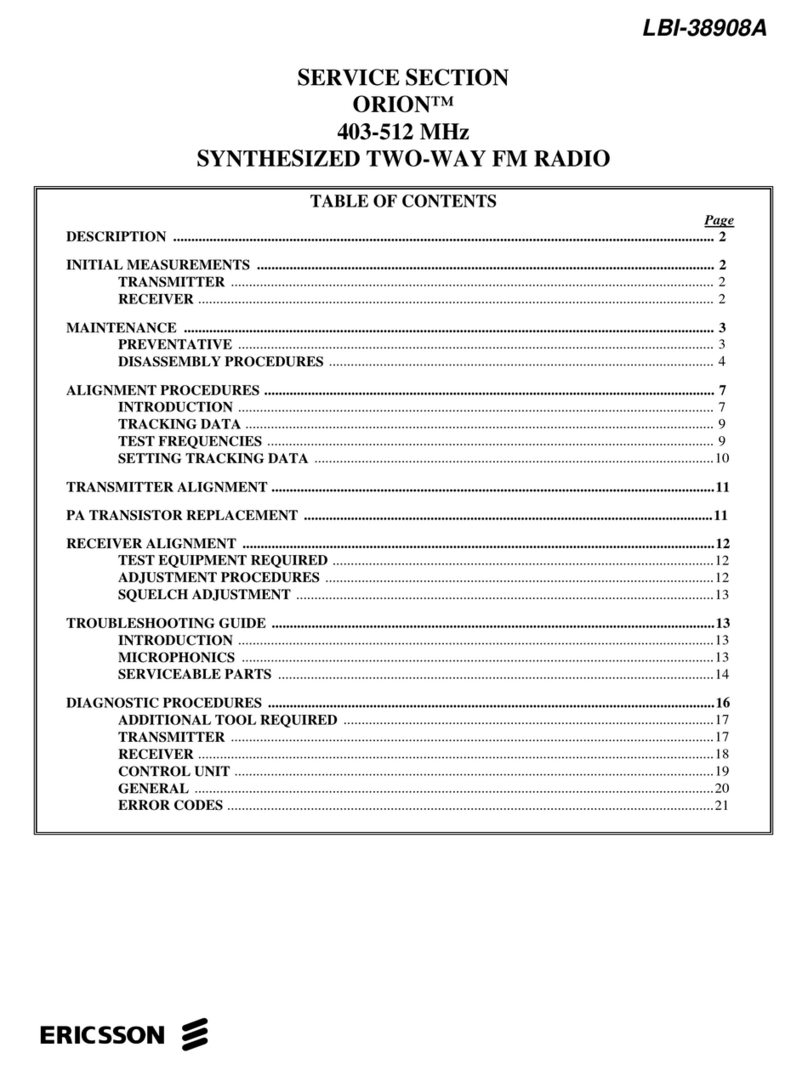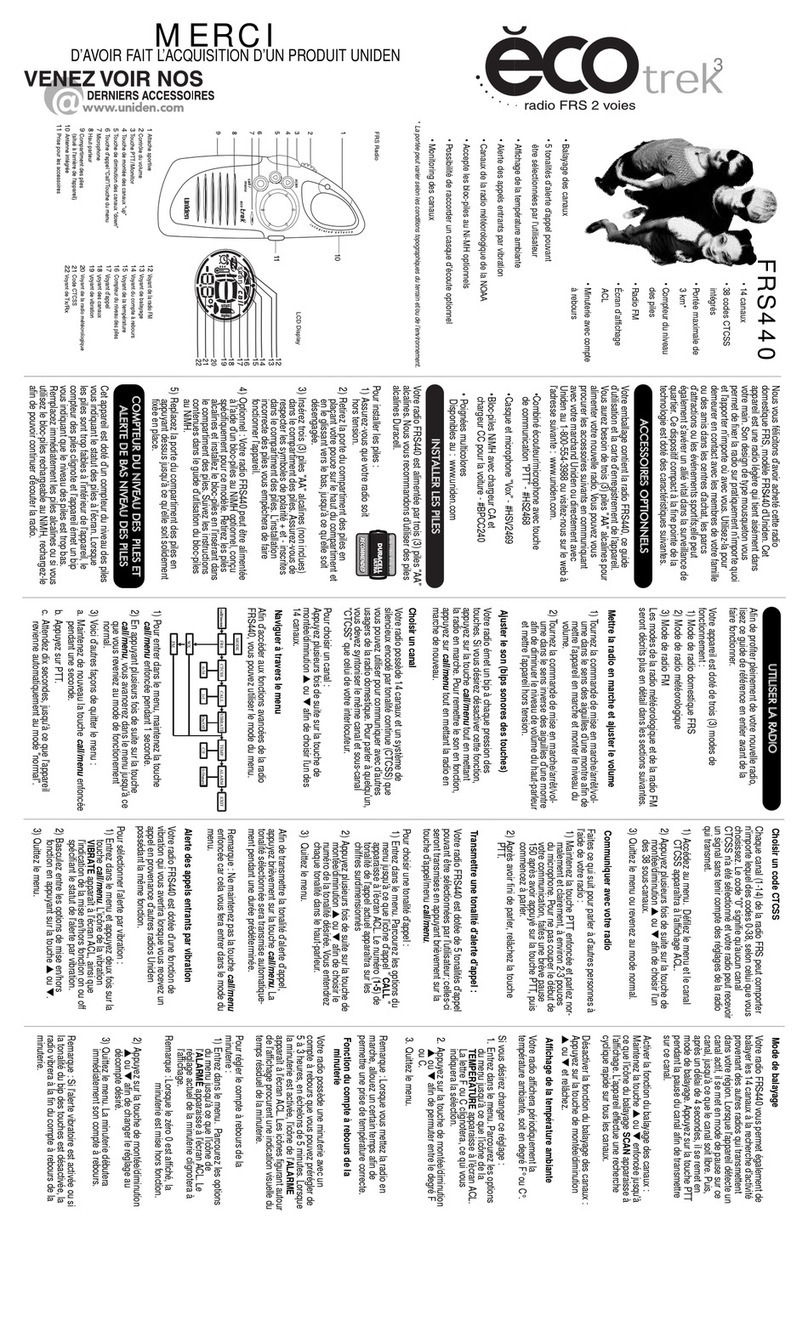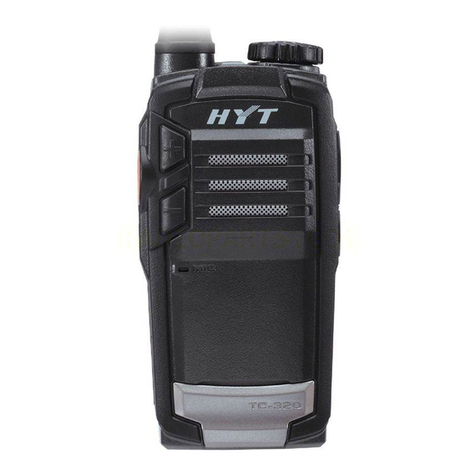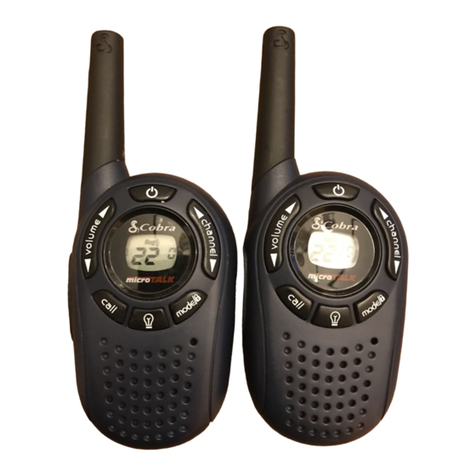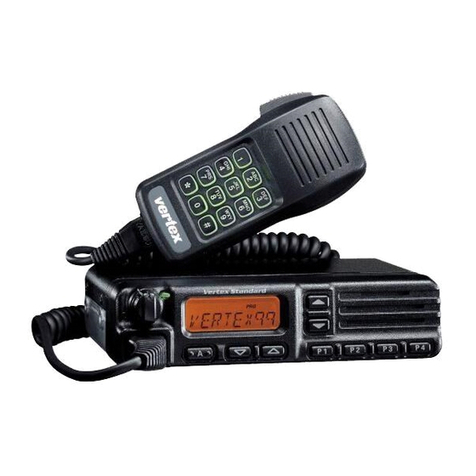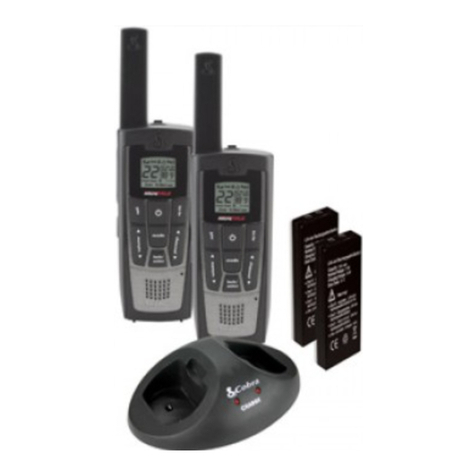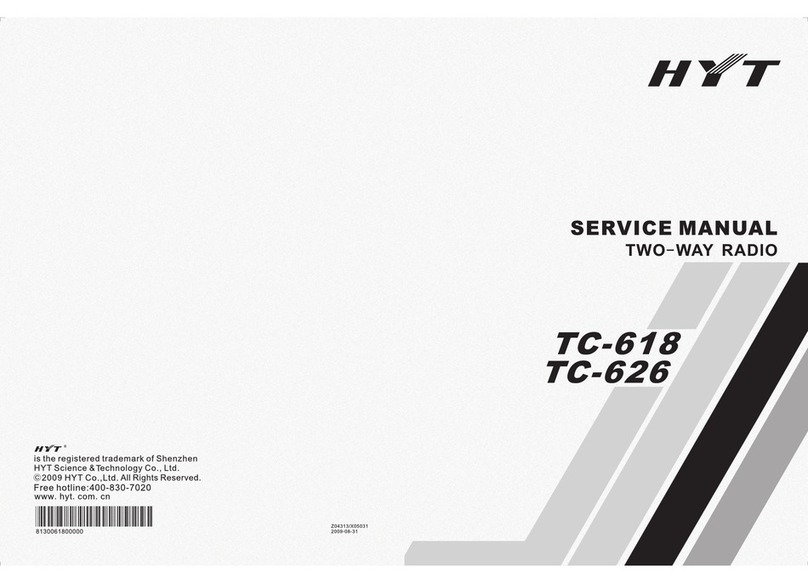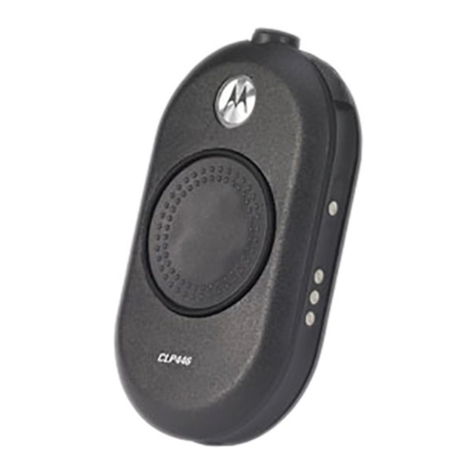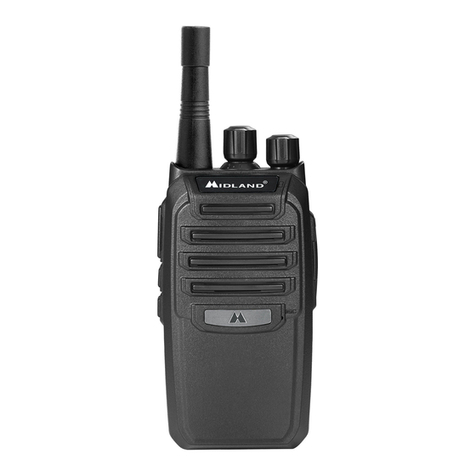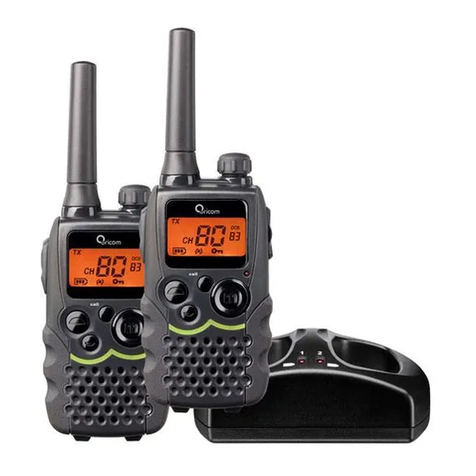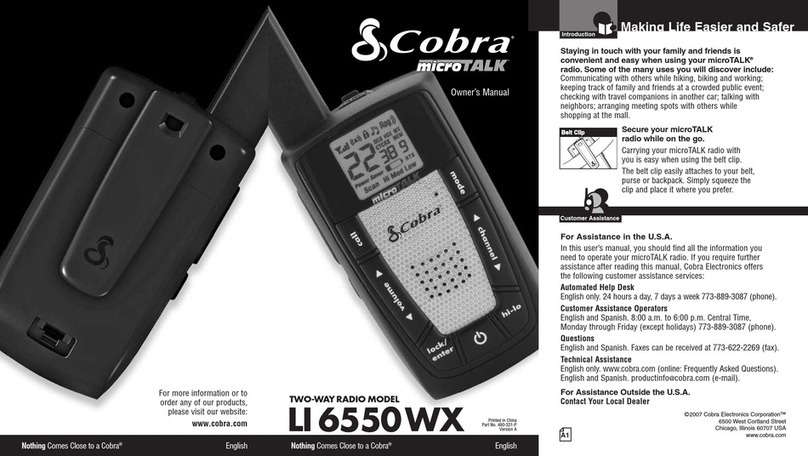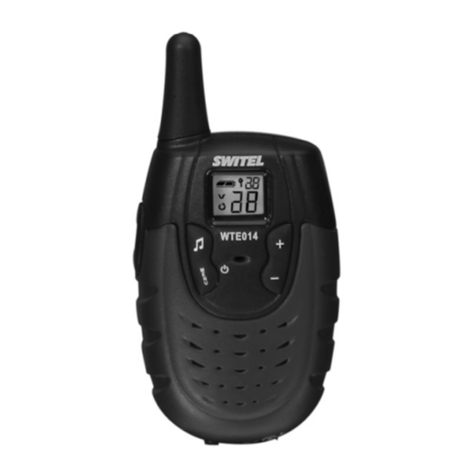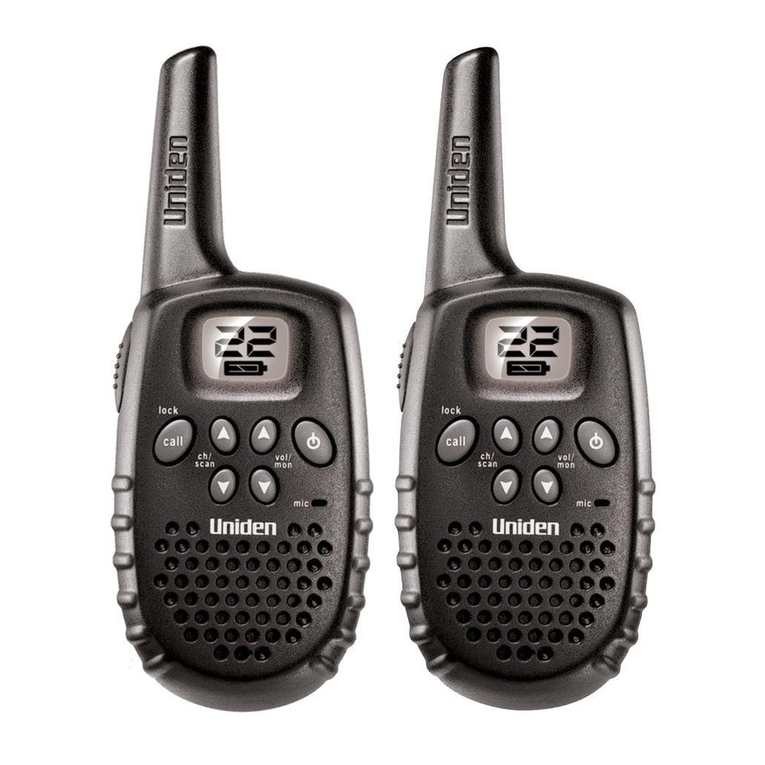Ericsson GE ORION LBI-39073 User manual

LBI-39073
1
SERVICE SECTION
ORION™
806 - 870 MHz
SYNTHESIZED TWO-WAY FM RADIO
TABLE OF CONTENTS
Page
DESCRIPTION............................................................................................................................................................... 2
INITIAL MEASUREMENTS......................................................................................................................................... 2
TRANSMITTER............................................................................................................................................... 2
RECEIVER ....................................................................................................................................................... 2
MAINTENANCE............................................................................................................................................................ 3
PREVENTATIVE............................................................................................................................................. 3
DISASSEMBLY PROCEDURES..................................................................................................................... 3
ALIGNMENT PROCEDURES....................................................................................................................................... 7
INTRODUCTION............................................................................................................................................. 7
TRACKING DATA .......................................................................................................................................... 9
TEST FREQUENCIES ..................................................................................................................................... 9
SETTING TRACKING DATA......................................................................................................................... 9
TRANSMITTER ALIGNMENT..................................................................................................................................... 10
PA TRANSISTOR REPLACEMENT............................................................................................................................. 11
RECEIVER ALIGNMENT............................................................................................................................................. 11
TEST EQUIPMENT REQUIRED.................................................................................................................... 11
ADJUSTMENT PROCEDURES...................................................................................................................... 11
SQUELCH ADJUSTMENT ............................................................................................................................. 12
TROUBLESHOOTING GUIDE..................................................................................................................................... 12
INTRODUCTION............................................................................................................................................. 12
MICROPHONICS............................................................................................................................................. 12
SERVICEABLE PARTS................................................................................................................................... 13
DIAGNOSTIC PROCEDURES...................................................................................................................................... 14
ADDITIONAL TOOL REQUIRED.................................................................................................................. 14
TRANSMITTER............................................................................................................................................... 15
RECEIVER ....................................................................................................................................................... 16
CONTROL UNIT ............................................................................................................................................. 17
GENERAL ........................................................................................................................................................ 18
ERROR CODES................................................................................................................................................ 18

LBI-39073
2
DESCRIPTION
This section contains the information required to
service the ORION 800 MHz two-way FM mobile radio.
Included are disassembly procedures, alignment
procedures and troubleshooting information (see Table of
Contents).
This radio is adjusted by setting personality
parameters stored in the radio computer memory.
Therefore, all radio alignment procedures require the use
of a Personal Computer (PC) (IBM PC, or equivalent)
along with an Ericsson GE Programming Interface
TQ3370, and ORION PC Programming cable TQ3377.
Ericsson GE PC Programming Software Version 3.00 or
later is also required.
This radio is designed to be serviced by replacement
of modules and/or circuit boards. As such, there are very
few serviceable component parts contained on any of the
circuit boards within the radio. Normally, defective boards
should be replaced and returned to an Authorized Ericsson
GE Service Center. Any serviceable parts are listed in the
troubleshooting guide for the individual circuit boards.
INITIAL MEASUREMENTS
After the radio has been installed as described in the
Installation Manual, the following measurements should
be made by a certified electronics technician and recorded
for future reference:
TRANSMITTER
•RF power into 50 ohm resistive load
•Forward power into antenna
•Reflected power from antenna
•Carrier frequency
•Modulation deviation
RECEIVER
•12 dB SINAD sensitivity
CopyrightMay 1994, Ericsson GE Mobile Communications Inc.

LBI-39073
3
MAINTENANCE
PREVENTIVE MAINTENANCE
NOTE
To ensure high operating efficiency, and to prevent mechanical and electrical failures from interrupting system
operations, routine checks should be made of all mechanical and electrical equipment at regular intervals. This preventive
maintenance should include the checks as listed in Table 1, Maintenance Checks.
Table 1 - Maintenance Checks
MAINTENANCE CHECKS INTERVAL
CONNECTIONS - Ground connections and connections to the voltage source should
be periodically checked for tightness. Loose or poor connections to the power source
will cause excessive voltage drops and faulty operation. When ground connections are
not made directly to the battery, the connection from the battery to vehicle chassis must
be checked for low impedance. A high impedance may cause excessive voltage drops
and alternator noise problems.
Every
6
months
ELECTRICAL SYSTEM - Check the voltage regulator and alternator or generator
periodically to keep the electrical system within safe and economical operating limits.
Over voltage is indicated when the battery loses water rapidly. Usage of 1 or 2 ounces
of water per cell per week is acceptable for batteries in continuous operation. A weak
battery will often cause excessive noise or faulty operation.
As
Required
MECHANICAL INSPECTION - Since mobile units are subject to constant shock and
vibration, check for loose plugs, nuts, screws, and parts to make sure that nothing is
working loose. Be sure that all screws are properly torqued. Every 6
months
ANTENNA INSPECTION - The antenna, antenna base, and all contacts should be kept
clean and free from dirt or corrosion. If the antenna or its base should become coated or
poorly grounded, loss of radiation and a weak signal will result. Every 6
months
ALIGNMENT - The transmitter and receiver meter readings should be checked
periodically, and the alignment "touched up" when necessary. Refer to the applicable
Alignment Procedure and troubleshooting sheet for typical voltage readings. As
Required
FREQUENCY CHECK - Check transmitter frequency and deviation, as required by
the FCC. Normally, these checks are made when the unit is first put into operation, after
the first six months, and once a year thereafter. As
Required

LBI-39073
4
DISASSEMBLY PROCEDURE
To Remove Unit From Mounting Bracket
1. Remove the microphone, power and accessory/remote
control cables, as required.
2. Remove the lock screws at the side of the radio unit,
using a #20 TORX®driver.
3. Pull the radio out of the mounting bracket.
To Gain Access To The Circuitry For Servicing
RF Power Amplifier Module:
1. Remove the waterproof cover on bottom of the
module, using a #20 TORX driver. Note that the four
mounting screws are captivated to the cover.
2. Remove the inner shield by pulling with the attached
handle.
Transceiver (TXRX) Module:
1. Remove the waterproof top and bottom covers using
#20 TORX driver. Four cover mounting screws are
located on the bottom of the module. These screws
are captivated to the bottom cover.
2. To expose the Logic/Audio/455 kHz IF circuitry,
remove the shield on top of the module by pulling
with the attached handle.
3. To expose the Exciter/RX front end circuitry, remove
the shield on the bottom of the module by pulling
with the attached handle.
NOTE
The VCO/Synthesizer circuitry is exposed by removing
screws from the shield casting, also located on the bottom
of the module. However, this is not recommended, except
in extreme situations. If the shield is removed, it should be
replaced using exact screw torque and installation
sequence given in maintenance manual LBI-38909.
Control Unit (Front Mounted):
1. Expose Logic/Audio/455 kHz IF circuitry according
to instructions 1 and 2 above.
2. Disconnect Flex Circuit PC2 from connector J701, by
carefully disengaging the locking tab from each side
of the connector with a jeweler's screwdriver or
tweezers. Use extreme care not to damage plating
runs or surface mounted components on the printed
wire board during this procedure.
3. Turn the radio upside down, and disengage the two
mounting screws, using #10 TORX driver. Be sure to
engage the screws in the captivation threads on the
transceiver chassis. Do this by pulling each screw
upward with tweezers or needle nose pliers, while
simultaneously turning the screw counterclockwise
with the TORX (cr ) driver. See maintenance manual
LBI-38909 for more details.
4. Disengage the control unit from the transceiver
chassis using a pivoting motion about the top edge of
the transceiver chassis.
5. Disengage the four captivated screws on the rear
cover, using #10 TORX driver. Slide the rear cover
off the front panel assembly, using care not to damage
the black "O-Ring" moisture gasket attached to the
rear cover. Note that flex circuit PC2 slides through a
slot opening on the rear cover.
Control Head (Remote Mounting)
1. Disconnect the remote control and accessory cables,
using a small flat blade screwdriver.
2. Remove the two side mounting screws from the
mounting bracket. Carefully remove the control head
assembly from the bracket.
3. Disengage the four captivated screws on the rear half
, also known as the Remote Interface Adapter (RIA)
of the control head. Slide the two halves apart, using
care not to damage the black "O-Ring" moisture
gasket attached to the RIA.
4. Disconnect flex circuit PC2 from connector J2, by
carefully disengaging the locking tab from each side
of the connector with a jeweler's screwdriver or
tweezers. Use extreme care not to damage plating
runs or surface mounted components on the printed
wire board during this procedure.
To Reassemble The Radio After Service
Essentially follow the reverse of the above
instructions. However, in order to preserve moisture seals,
be sure to follow the EXACT torque and sequencing
specifications for screw engagement during reassembly.

LBI-39073
5
These specifications are given in maintenance manual
LBI-38909.
NOTE
For re-assembly of the Control Units (Front and Remote
Mounting) Revision "A" or later, be sure the black "O-
Ring" is lubricated properly with "HIVAC-G" silicone
grease (See Figures 1A and 1B for instructions).
Steps:
1. Remove dust and dirt from the black O-Ring gasket.
2. Apply proper amount of the silicone grease to a cloth
as shown in Figures 1A and 1B.
3. Put the silicon grease on the black O-Ring gasket,
covering the surface of the gasket evenly (see Figure
1A and 1 B).
CAUTION
No Fibers of the cloth must remain on the gasket after the
silicone is applied.
4. Wipe out protruded silicone grease form the
Rear/RIA Cover.

LBI-39073
6
Figure 1A - Front Mount Control Unit "O-Ring" Lubrication
Figure 1B - Remote Mount Control Unit "O-Ring" Lubrication

LBI-39073
7
ALIGNMENT PROCEDURES
INTRODUCTION
All operations of this radio are controlled by an
embedded digital computer, which is programmed with a
personality unique to the customer. In order to align and
test the radio, it must be programmed with a specific test
personality, which will allow conventional operation on
certain test frequencies. Certain tests can be carried out by
altering the personality. Furthermore, certain commands,
known as Test Mode Commands, cause the radio to
perform specific test functions. These will be noted as
required in the following alignment and troubleshooting
instructions.
In order to program an ORION personality, the radio
and control unit must first be connected to a personal
computer through PC Programming Cable and Hardware
Programming Interface TQ3370, in one of the
configurations shown in Figure 2. Accessories may be
connected to the appropriate accessory cable
19B802554P1-P4 as needed.
The PC must be equipped with the Ericsson GE PC
Programming Software, Version 4.0 or later. It is assumed
in this manual that the Service Technician is familiar with
the operation of the PC Programming Software programs
"EDACS3" and "MRKMAINT". Consult the PC
Programming Software manuals for further details
regarding this software.
CAUTION
Before bench testing the radio, be sure of the output
voltage characteristics of your bench power supply.
To protect the transmitter power output transistors from
possible instant destruction, the following input voltages
must not be exceeded.
Transmitter unkeyed 16.5 Volts
Transmitter keyed
(50 ohms resistive load) 16.3 Volts
Transmitter keyed
(No load or non-resistive load) 14.0 Volts
These voltages are specified at the normal vehicle battery
terminals of the radio and take the voltage drop of
standard cables into account. The voltage limits shown for
a non-optimum load is for "worst case" conditions. For
antenna mismatches likely to be encountered in practice,
the actual limit will approach the 16.3 Volt figure.
Routine transmitter test should be performed at EIA
Standard Test Voltages (13.6 Vdc for loads of 6 to 16
amperes; 13.4 Vdc for loads of 16 to 36 amperes). Input
voltages must not exceed the limits shown, even for
transient peaks of short duration.
Many commonly used bench power supplies cannot meet
these requirements for load regulation and transient
voltage suppression. Bench supplies which employ
"brute force" regulation and filtering (such as Lapp
Model 73) may be usable when operated in parallel with a
12 Volt automotive storage battery.

LBI-39073
8
Figure 2 - ORION Programming Configurations

LBI-39073
9
TRACKING DATA
The radio personality contains certain information
bytes known as Tracking Data, which allow the radio
computer to calibrate transmitter power , modulation
deviation and squelch threshold. Normally, no
adjustments need be made to the radio to maintain
specified limits for the above parameters, since the radio
computer makes the necessary adjustments using the
Tracking Data established at the factory. However, should
the transmitter PA, synthesizer or logic circuit boards be
replaced, it may be necessary to alter the Tracking Data to
re-set these parameters properly. Furthermore, if the
Tracking Data is lost, specialized procedures are required
to load new Tracking Data. Therefore, it is VERY
IMPORTANT to establish a record of the Tracking Data
of every radio as it is received from the factory. The
frequencies at which Tracking Data is established are
given in the "Test Frequencies" section.
TEST FREQUENCIES
The following frequencies are those for which
Tracking Data is established and are used as Test
Frequencies:
TABLE 2 - TRACKING DATA FREQUENCIES - TX RF POWER/RX SQUELCH
Parameter TX RPT INPUT TX TALK AROUND Squelch Set
fH(MHz) 806.0000 851.0000 851.0000
fLM (MHz) 810.7500 855.7500 855.7500
fM(MHz) 815.5000 860.5000 860.5000
fMH (MHz) 820.2500 865.2500 865.2500
fH(MHz) 825.0000 870.0000 870.0000
TABLE 3 - TRACKING DATA FREQUENCIES - TX MODULATION
Parameter Modulation Deviation
f1L(MHz) 806.0000
f1H(MHz) 815.5000
f2L(MHz) 815.5125
f2H(MHz) 825.0000
f3L(MHz) 851.0000
f3H(MHz) 860.5000
f4L(MHz) 860.5125
f4H(MHz) 870.5000
SETTING TRACKING DATA
Normally, tracking data is set at the factory and need not be reloaded. However, the following repair situations
require reloading some or all of the tracking data:
SITUATION NEW TRACKING DATA REQUIRED
Replace PA module RF Power, Squelch (Reload if necessary)
Replace TXRX module RF Power, Modulation Deviation, Squelch, Feature Encryption, Data Offset
Replace Control Unit None
Replace synthesizer Board Modulation Deviation, Data Offset
Replace Logic Board RF Power, Squelch, Modulation Deviation, Feature Encryption, Data Offset

LBI-39073
10
To reload Tracking Data, connect the radio in the
appropriate configuration as shown in Figure 1 or 2, and
perform the following steps:
1. When using the Ericsson GE PC Programming
Software, make sure the radio is programmed in the
following sequence:
a. Customer Operational Software (If necessary)
b. Tracking Data (1st Iteration - Tracking Data
originally shipped with the radio is a good
starting point
c. Feature Encryption File (If necessary). Note that
in order to load an Encryption File into a new
Logic board, Ericsson GE Service Parts
Department must first be contacted at
1-800-368-3277 for the authorization code.
Otherwise, the file will not load.
d. Personality, which contains a
CONVENTIONAL SYSTEM using the
frequencies given inTable 2 or Table 3.
2. Connect the radio unit in the normal operating
configuration. Activate the radio unit and using
aService Monitor HP8920A or equivalent. Measure
transmitter power, modulation deviation and squelch
threshold for each of the applicable frequencies given
in Table 2 or Table 3. Measurements should be
within the following limits:
PARAMETER LIMIT
TX Modulation Deviation 4.4 ± 0.1 kHz
TX High Power
35/30 Watt Model 806-825 MHz 35 +3, -0 Watts
851-870 MHz 30 +3, -0 Watts
12 Watt Model 12 +1.5, -0 Watts
TX Low Power
35/30 Watt Model 19 +0.5, -0.5 Watts
12 Watt Model 6 +0.5, -0.5 Watts
RX Squelch Threshold 8 +0.5, -0.5 dB
SINAD
NOTE
When measuring TX power it is extremely important to
account for RF cable and connector losses at 800 MHz.
Use only short cable lengths, and use the largest diameter
cable possible with the radio unit. Also, use new
connectors where possible. Discard any connectors which
are worn or bent out of shape.
3. If measurements are within limits, the job is
complete. If not, reconnect in the programming
configuration according to Figures 1 or 2 and execute
the programming maintenance software
"MRKMAINT". Display the Tracking Data screen.
For those frequencies where measurements are not
within limits, enter new Tracking Data, following
instructions on the screen. Program into radio
personality and exit.
4. Repeat Steps 2 and 3 until measurements at every
frequency given in Table 2 or 3 are within the limits
specified above.
TRANSMITTER ALIGNMENT
The transmitter consists of synthesizer, exciter and
power amplifier. These have been calibrated at the factory
such that the radio computer automatically adjusts RF
power and modulation deviation, based upon Tracking
Data. The following adjustments can be made by Ericsson
GE PC Programming Software:
CAUTION
DO NOT CHANGE TRACKING DATA UNLESS THE
PA MODULE OR LOGIC BOARD HAS BEEN
REPLACED. DO NOT CHANGE TRACKING DATA
FOR ANY FREQUENCY OTHER THAN THAT
GIVEN IN TABLES 2 OR 3.
1. Modulation Deviation - Change Tracking Data
using "MRKMAINT" maintenance software.
Follow the procedure given in "TRACKING
DATA" section. Be sure to record new tracking data
and modulation levels.
2. RF Power - Set RF power for system (EDACS) or
channel (CONVENTIONAL) in radio personality,
using "EDACS3" programming software.

LBI-39073
11
There are no other adjustments to be made on the
transmitter. However, there are components located on the
synthesizer and power amplifier, which appear to be
adjustable. These are summarized as follows:
SYNTHESIZER CV201, CV202, RV201
POWER AMPLIFIER (35/30 WATT) RV1
POWER AMPLIFIER (12 WATT) RV1
These components have been set at the factory, and
are NOT ADJUSTABLE. ANY READJUSTMENT OF
THESE COMPONENTS WILL VOID THE
WARRANTY OF THIS PRODUCT.
PA TRANSISTOR REPLACEMENT
WARNIN
G
The RF Power Transistors used in the transmitter contain
Beryllium Oxide, a TOXIC substance. If the ceramic or
other encapsulation is opened, crushed, broken, or
abraded, the dust may be hazardous if inhaled. Use care
in replacing transistors of this type.
To Replace the PA RF Transistors
1. Unsolder one lead at a time with a 50-watt soldering
iron. Use a scribe or X-actoknife to hold the lead
away from the printed circuit board until the solder
cools. Remove the mounting screws.
2. Lift out the transistor. Remove any old solder from
the printed circuit board with a vacuum de-soldering
tool. Special care should be taken to prevent damage
to the printed circuit board runs because part of the
matching network is included in the base and
collector runs.
3. Trim the new transistor leads (if required) to the lead
length of the removed transistor.
4. Apply a coat of silicone grease to the transistor
mounting surface. Place the transistor in the mounting
hole. Align the leads as shown on the Outline
Diagram. Then replace the transistor mounting screws
using moderate torque (9.4 kg.cm).
5. Solder the leads to the printed circuit pattern. Start at
the inner edge of the mounting hole and solder the
remaining length of transistor lead to the board. Take
care not to use excessive heat that causes the printed
wire board runs to separate from the board. Check for
shorts and solder bridges before applying power.
CAUTION
Failure to solder the transistor leads as directed may result
in the generation of RF loops that could damage the
transistor or may cause low power output.
RECEIVER ALIGNMENT
Alignment of the Front End and Local Injection
circuits are not required because band-pass filters are
employed in the ORION wide-band synthesized radio
receiver.
TEST EQUIPMENT REQUIRED
•Distortion Analyzer
•AC Voltmeter
•RF Signal Generator
•Frequency Counter (806-870 MHz)
•4-Ohm, 25-Watt Resistor
•Audio Isolation Transformer (1:1)
19A116736P1 or equivalent
NOTE
Before aligning the receiver or making any adjustments to
the radio, be sure that the output of the 9-Volt Regulator is
9.0 ±0.2 Vdc.
ADJUSTMENT PROCEDURES
Receiver Frequency Adjustment
No receiver frequency adjustment is required.

LBI-39073
12
2nd Receiver Oscillator
Using a frequency counter monitor TP5 Terminal, set
L521 for a frequency of 82.655 MHz ±200 Hz.
IF/FM Detector Alignment
1. Apply a 1000 micro volt, on-frequency test signal
modulated by 1,000 Hz with standard deviation to
antenna jack J1.
2. Connect a 4-ohm, 25-watt resistor in place of the
speaker. Connect the isolation transformer input
across the resistor. Connect the isolation transformer
output to the Distortion Analyzer (see Figure 3).
3. Adjust the VOLUME control for 15 watts output
(7.75 VRMS) using the Distortion Analyzer as a
voltmeter.
4. Set the output signal level of the RF signal generator
so as to obtain 12 dB SINAD at audio output.
5. Adjust coils L502, L504, L505, and L507 to obtain
minimum 12 dB SINAD.
6. Set the output signal level of the RF signal generator
to 1000 microvolts.
7. Adjust L523 for maximum audio output.
8. Adjust RV501 for XTONEDEC output at ORCC to
500 mVRMS.
SQUELCH ADJUSTMENT
Squelch threshold has been set at the factory to 8 dB
SINAD. Adjustment of the threshold requires changing
the tracking Data. To change the squelch tracking data,
follow the iterative procedure set forth in the
"TRACKING DATA" section, except let the desired
squelch threshold level replace the 8 +0.5, -0.5 dB
SINAD level set at the factory. BE SURE TO CHANGE
THE TRACKING DATA FOR ALL FREQUENCIES
GIVEN IN TABLE 2 OR 3. Otherwise the level will not
be consistent across the frequency band.
TROUBLESHOOTING GUIDE
INTRODUCTION
This radio is designed to be serviced by replacement
of modules an/or circuit boards. As such, there are very
few serviceable component parts contained on any of the
circuit boards within the radio. Normally, defective boards
should be replaced and returned to an Authorized Ericsson
GE Service Center. A list of serviceable parts is given in
the next section.
MICROPHONICS
Synthesized radios tend to be sensitive to shock and
vibration, creating microphonics. The construction of the
ORION radio with its die-cast aluminum frame, cast
shield, and multiple board-mounting screws, provides a
high degree of immunity. When removing printed circuit
boards or shields, note the location of all mounting
hardware.
Figure 3 - Audio Isolation Transformer
NOTE
Isolation transformer needed only if instrument cannot be isolated from ground at
input terminals.
4-OHM
LOAD
1 : 1
DISTORTION
ANALYZER
OR
AC VOLTMETER
ISOLATION
TRANSFORMER

LBI-39073
13
When servicing the radio be sure that no solder build-
up has occurred on the chassis or shield.
To assure a high degree of resistance to microphonics
be sure to replace exactly, all hardware removed. Be sure
that all mounting screws are properly torqued and shields
are in place. Refer to the Mechanical Layout Diagram
found in LBI-38909.
NOTE
Loose or rubbing parts, especially in the VCO area, are
particularly sensitive and can cause microphonics. Again,
be certain all hardware is properly installed and torqued.
SERVICEABLE PARTS
Control Unit - Switch Circuit CDF-368B/M
No serviceable parts.
Control Unit - Panel Control CMC-638
No serviceable parts.
Remote Control Unit - RIA NQZ-4882
J2 Connector, 18 pin B19/5JBAX00020
Radio Unit - System Control Logic CMC-682
F601 Fuse, 5 amp. B19/5ZFAP00008
IC604 AF Power Amplifier B19/5DAAA00350
J701 Connector, 18 pin B19/5JDAG00315
Radio Unit - IF CMF-138P
No Serviceable parts.
Radio Unit - Synthesizer/Receiver/Exciter CMN-358
No Serviceable parts.
Radio Unit - Power Amplifier CAH-585L, CAH-585H
12Watt Model CAH-585L
HC1 Power Amplifier Module B19/5DHAA0053
HC2 Power Amplifier Module B19/5DDAB00509
IC1 Positive Voltage Regulator B19/DAAA00428
35/30 Watt Model CAH-585H
HC1 Power Amplifier Module B19/5DHAA0053
HC2 Power Amplifier Module B19/5DDAB00509
TR1 Silicon: NPN B19/5TCAD00145
IC1 Positive Voltage Regulator B19/DAAA00428
C15
and
C16
Ceramic: 15 pF ±5% 100
VDCW, temp coef 0±60 PPM. B19/5CAAA03101
C17
and
C18
Metal mica: 22 pF ±5% 100
VDCW. B19/5CAAH00024

LBI-39073
14
DIAGNOSTIC PROCEDURES
This product can be easily measured for maintenance using a Communications Service Monitor, of which several models
are available. A typical test configuration for the ORION product is shown in Figure 4.
NOTE
It is also possible to combine this test configuration with the PC programming configuration shown in Figure 2. This
usually results in increased efficiency, since the service technician can alternate between programming and hardware
testing, as the need arises.
Figure 4 - Typical ORION Test Configuration
ADDITIONAL TOOLS REQUIRED:
•RF Power Attenuator (30 dB, 150 watt, for transmitters with RF power beyond capability of the Service Monitor)
•Digital Voltmeter
•Oscilloscope (Optional)

LBI-39073
15
TRANSMITTER
SYMPTOM DIAGNOSTIC PROCEDURE
No RF power output a) Program a conventional system with frequencies given in Table 2 or 3. Use the
"EDACS3" PC Programming utility.
b) Check RF Power Tracking Data, using the "MRKMAINT" PC programming utility.
Data should be the same as that shipped with the radio. If fail, re-enter Tracking data
using procedure given in the "Tracking Data" Section of this manual.
c) Check TP1 on PA board for A+.If no A+ present, check power cable fuse.
d) Key the radio and measure the DC voltage at TP4 (9 Vdc typical, when keyed). If not
there, trace TXENABLE signal back to Logic board.
e) Unscrew PA module from rest of the radio unit. Remove P1 from J151 and connect an
RF wattmeter to J151. Power should be 9 ±5 mW. If not, replace Synthesizer board and
reload the Modulation Tracking Data. If the correct power level is there, replace PA
board.
Frequency too low/high Adjust the reference oscillator XU201 on the Synthesizer board. If the frequency still not
correct, replace the Synthesizer board.
Low or no modulation a) Program a conventional system with frequencies given in Tables 2 or 3. Us the
"EDACS3" PC programming utility.
b) Check the Modulation Tracking Data, using the "MRKMAINT" PC programming
utility. The data should be the same as that shipped with the radio. If not, re-enter the
Tracking Data using the procedure given in the "Tracking Data" section of this manual.
c) Apply a 1000 mVRMS, 1 kHz audio signal to the microphone connector, Pin 1 (Pin 2 is
ground reference). Key the radio (make sure the antenna connector is connected to the
proper 50 ohm load). Check for an audio signal at TP202 on the Synthesizer board. If not
there, replace the Synthesizer board and reload the Modulation Tracking Data.

LBI-39073
16
RECEIVER
SYMPTOM DIAGNOSTIC PROCEDURE
Low RF sensitivity a) Program a Conventional System with frequencies given in Tables 2 or 3. Use
"EDACS3" PC programming utility.
b) Unscrew the PA module from the TXRX module. Disconnect coaxial cable P2 from J401
on the Synthesizer board. Do not disconnect any other cable.
c) Set the frequency of the RF signal generator to the middle of the split. Apply a standard
RF signal to J401 and measure 12 dB SINAD sensitivity. Sensitivity should be better
than 0.29 µV.
d) If correct, replace the PA board.
e) If not, realign the receiver, as instructed in the "ALIGNMENT" section and recheck
sensitivity at J401.
f) If correct now, reassemble with the PA module and recheck sensitivity at the antenna
connector. If correct, the job is complete.
g) If not correct, substitute a known good Synthesizer board and recheck sensitivity.
h) If still not correct, replace the Logic board. Be sure to perform complete reprogramming
on the new logic board. If correct , replace the Synthesizer board and reload Modulation
Tracking Data.
High audio distortion a) Program a Conventional System with frequencies given in Tables 2 or 3. Use the
"EDACS3" PC programming utility.
b) Apply a standard 1000 µV RF signal (with 1 kHz audio modulation at 3 kHz deviation)
at one of the programmed RF frequencies in the center of the split to J1001. Set the
volume control to produce 15 watts at the 4 ohm speaker load.
c) Measure audio distortion at "VOL HI" output (J1003, Pin 13 referenced to Pin 12). If
correct (3% THD), replace IC604 Audio Power Amplifier on the Logic board.
d) If not, realign the receiver according to the alignment procedure. Recheck
distortion at the speaker load or "VOL HI".
e) If not correct, replace the Logic board. If correct, job is complete.

LBI-39073
17
CONTROL UNIT
SYMPTOM DIAGNOSTIC PROCEDURE
Radio dead at
power-on (display
dark and no
lighted indicators)
a) Check battery connections and the Red Lead A+ fuse on the Power Cable.
b) Turn unit "OFF", then simultaneously press and hold "EMERGENCY" and
"OPTION" buttons, while turning the unit "ON". All indicator lights and all display
dots should light. Release the buttons and the display should show the following
message:
EGE- 1993
This indicates that the Control Unit is functioning correctly. If correct, check
programming and feature encryption, using the "EDACS3" PC programming utility.
c) If not correct, measure A+ voltage at the microphone connector, Pin 6 (reference
ground at Pin 7). If not present, check fuse F601 on the Logic board for A+ on each
side of part. Replace if open circuited.
d) If the fuse is OK, check the connection of Flex Circuit PC2 with J701 on the Logic
board. If still not present, reconnect, making sure side tabs are locked. Recheck
microphone connector Pin 6 for A+.
e) If A+ is present, Check programming and feature encryption, using "EDACS3" PC
programming utility. If symptom persists, substitute a known good Logic board and
reprogram.
f) If no A+ is at the microphone, Pin 7, check for A+ on the Logic board, J704, Pin 3. If
not there, check the J704/J1004 connection. If still not there, replace the PA module. If
there, replace the Logic board.
Display lights, then goes
dead a) Turn unit "OFF", then simultaneously press and hold the "EMERGENCY" and
"OPTION" buttons, while turning the unit "ON". All indicator lights and all display dots
should light. Release the buttons and the display should show the following message:
EGE- 1993
This indicates that the Control Unit is functioning correctly. If OK, check programming
and feature encryption, using "EDACS3" PC programming utility.
b) If OK, check connection of Flex Circuit PC2 with J701 on the Logic board. If not OK,
reconnect , making sure side tabs are locked.

LBI-39073
18
GENERAL
SYMPTOM DIAGNOSTIC PROCEDURE
Any Hardware malfunction Printed Wire Board substitution is a valid technique for service and repair of the ORION
product, since there are only a few circuit boards in the product:
1) RF Power Amplifier
2) Logic/IF/Audio
3) Synthesizer/Exciter/RX Front End
4) Control Unit Panel Control
5) Control Unit Switching
6) Control Unit RIA (Remote only)
7) DSP (AEGIS only)
The service shop should be equipped with a set of the above circuit boards which
can be used for substitution. Defective circuit boards can be isolated simply by substituting
one at a time. It is recommended that the Logic board used for substitution be pre-
programmed with a conventional system and frequency set given in Tables 2 or 3.
ERROR CODES
This section list all of the ORION radio errors and
warnings. Each error code in the list includes an
explanation of what went wrong and what action to take to
correct the problem. These error codes are divided into
three different categories:
1. Fatal Operational Error Codes - These are errors
that are displayed during the radio normal operation
or on the radio power-up (Fatal System Errors).
These errors will cause the radio to reset.
2. Non-Fatal Operational Error Codes - These are
errors that are displayed during the radio normal
operation or on the radio power-up. The radio will
NOT reset.
3. Radio Programming Errors - These are errors that
are displayed on the radio or the programming PC
display during radio programming.
All System Groups ORION
System Errors:
Fatal system errors will cause the radio to display an
error message/code and then reset the radio to the starting
operation. The reset condition will remain until the fatal
error(s) is (are) corrected.
Non-Fatal errors are displayed for a short period
(about 2 seconds) then normal radio operation will
resume.
The errors are displayed on the radio as shown in
Figure 5.

LBI-39073
19
message
ERR = xxxx where xxx is the error code and the message is
one of the messages listed below
Figure 5 - Error Message/Code Display
FATAL ERRORS NON-FATAL ERRORS
ERROR MESSAGE DESCRIPTION ERROR MESSAGE DESCRIPTION
HARDWARE ROM errors UNKNOWN
SOFTWARE General software failure FEAT ERR Feature encryption error
TRACKING Tracking data fatal error DSP ERR DSP error
NO LOCK Synthesizer not locking
FREQDATA Frequency data fatal error
PERSDATA Personality errors

LBI-39073
20
ROM Fatal Systems Errors
ROM fatal errors may be corrected by cycling the radio power (turn it off then on). When the power cycle does not
correct the problem the radio must be serviced.
ERROR NAME MESSAGE CODE DESCRIPTION
FATAL_SYS_TRAP HARDWARE 0 Fatal system error trap number.
FATAL_NMI_ERROR HARDWARE 1 NMI occurred outside of sleep.
FATAL_RAM_ERROR HARDWARE 2 8K RAM test error.
FATAL_ROM_CHKSUM HARDWARE 3 32K ROM checksum test error.
FATAL_FLSH_CHKSUM HARDWARE 4 Flash checksum test error.
FATAL_ASIC_LOAD HARDWARE 10 ASIC driver failed initialization.
FATAL_ICP_LOAD HARDWARE 11 ICP driver failed initialization.
FATAL_ASP_LOAD HARDWARE 12 ASP driver failed initialization.
FATAL_EE_LOAD HARDWARE 13 EEPROM driver failed initialization.
FATAL_ICP_PORTNIT HARDWARE 14 ICP digital I/O initialization failed.
FATAL_INTOUT_LOAD HARDWARE 15 Standard input/output driver failed initialization.
FATAL_INTIN_LOAD HARDWARE 16 Standard input driver failed initialization.
FATAL_RADIO_LOAD HARDWARE 17 RADIO driver failed initialization.
FATAL_MODEM_LOAD HARDWARE 18 MODEM driver failed initialization.
FATAL_EXTIO_LOAD HARDWARE 19 External I/O driver failed initialization.
FATAL_SCI_LOAD HARDWARE 20 Serial communication interface driver failed initialization.
FATAL _ICP_CHKSUM HARDWARE 21 ICP prom checksum.
FATAL_ADI_NOACK HARDWARE 30 ADI did not respond to command.
FATAL_LCD_NOACK HARDWARE 40 LCD did not acknowledge message.
FATAL_LCD_HARD_FAIL HARDWARE 41 LCD hardware is invalid.
FATAL_SCI_NOHEAP HARDWARE 50 Serial communication interface out of heap (RAM memory) space.
FATAL_ICP_NOACK HARDWARE 60 ICP did not acknowledge message.
FATAL_EXTIO_ICPFAIL HARDWARE 70 ICP failed in a fork.
FATAL_RADIO_ASPWRT HARDWARE 80 Radio driver could not write to ASP.
FATAL_ROM_NOHEAP HARDWARE 90 Software memory error - ROM task.
FATAL_BL_NOHEAP HARDWARE 91 Software memory error - Boot loader.
FATAL_BL_SCI_ATACH HARDWARE 92 Boot loader could not attach to SCI.
Operational Software Non-Fatal System Errors
ERROR NAME MESSAGE CODE DESCRIPTION
PIFEAT_SNR_ERROR FEAT ERR 550 Feature encryption - Can not read radio ROM serial number.
PIFEAT_READ_ERROR FEAT ERR 551 Personality feature encryption read failure or data not available.
PIFEAT_CRC_ERROR FEAT ERR 552 Decryption failure. Personality feature encryption CRC failure.
AEGIS_ADIDOWN_
NOTFOUND DSP ERR 851 DSP file not found.
AEGIS_ADIDOWN_
CRCFAIL DSP ERR 852 DSP file not found.
AEGIS_ADIDOWN_
ENCERR DSP ERR 853 Radio feature encryption does not match DSP file.
AEGIS_ADIDOWN_PMFAIL DSP ERR 854 DSP file is corrupted or hardware failure. RE-program radio or power cycle the
radio.
AEGIS_ADIDOWN_DMFAIL DSP ERE 855 DSP file is corrupted or hardware failure. Re-program radio or power cycle radio.
AEGIS_ADIDOWN_
BIOSERR DSP ERR 856 Hardware failure.
This manual suits for next models
1
Table of contents
Other Ericsson GE Two-way Radio manuals
